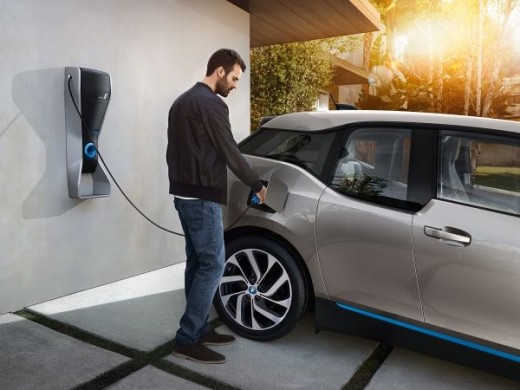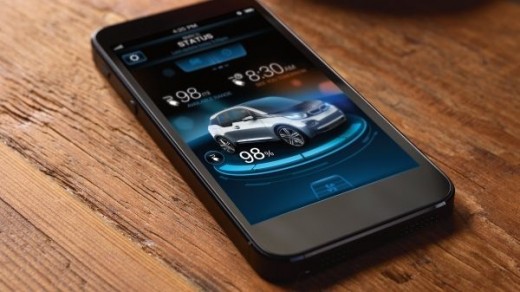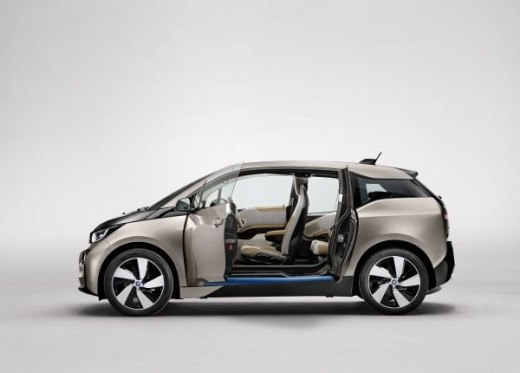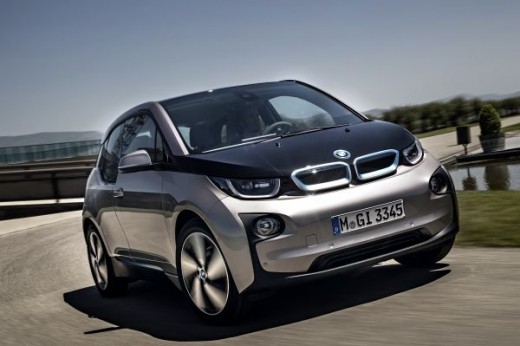2014 BMW i3 Review – era of true sustainable mobility
The premiere of brand new 2014 BMW i3, a pioneering model for this Bavarian car manufacturer, took place on three continents at the same time (in Beijing, London and New York). “I3 is more than a car. It is a revolutionary step towards sustainable mobility,” were the words of BMW boss Norbert Reithofer.
BMW is convinced that the new i3 is technically so advanced and useful it will improve the quality of life in large city metropolis. Preserving the nature is reflected not only with electric powered vehicle. The production line also uses renewable resources from hydro and wind power plants.
Read more about this amazing car, range details, charging info, technical specifications, measures, photos, and videos.
Charging and Range of BMW i3

BMW i3 Wallbox Charging
Research carried out by BMW shows that drivers on average travel 64 km per day (around 40 miles). Therefore the reach between 130 and 200 kilometers (80-125 miles) is quite enough for the vast majority of customers.
For those who are still afraid that they will stay in the middle of the road with empty batteries, BMW offers the possibility of an extended-range version with a rear-mounted 24 kW two-cylinder petrol engine. It is designed only to run the generator when energy in lithium-ion batteries is low. That increases the longest range of the car to around 340 kilometers (210 miles). In the EU measuring cycle, the reach of i3 is set at 190 kilometers (118 miles).
In quick recharging points, your i3 22-kilowatt pack of lithium-ion batteries will be at 100% in just 30 minutes. Charging at home via traditional connection lasts up to 8 hours. BMW i Wallbox is another option for home charging. This system reliably uses the maximum current available through your house wiring.
125 kW electric motor – fast acceleration, limited top speed
The basic I3 version is powered by 125 kW electric motor (170 HP). It can produce 250 Nm of torque which is available from 0 rpm onwards. The acceleration from 0 to 100 km/h looks very promising because the clock stops at 7 seconds, while top speed is limited to 150 km per hour (93 mph).
The Bavarians remain faithful to their philosophy of rear wheel drive.
The 650 ccm gasoline engine for charging the generator is available as an additional option. It provides a greater range of the car.
Lithium ion batteries are hidden in the bottom of the car and have 22 kWh capacity at 360V.
BMW ConnectedDrive

BMW i3 Smartphone App
Of course, the BMW i3 is fully integrated with the world through BMW ConnectedDrive. The built-in SIM card provides data transfer to and from the car and has many more useful functions:
- links to the smartphone application on your mobile
- calls for help if needed
- contacts BMW Service center
- plan the route according to the road conditions in order to extend the maximum range of the vehicle
BMW i3 Technical Data – specifications, measures, …

BMW i3 side view: rear doors open backward and the center pillar is completely removed.
Engine:
- Maximum power: 125 kW (170 HP)
- Max. torque: 250 Nm
- Acceleration 0-100 km/h (0-62 mph): 7.2 seconds
- Top speed: 150 km/h (93 mph)
Dimensions:
- Length: 4,00 m
- Width: 1,77 m
- Height: 1,58 m
- Wheelbase: 2,57 m
- Trunk capacity: 260 / 1,100 liters
Tires:
- front: 155/70 R19
- rear: 155/70 R19 (extended range model 175/65 R19)
Pricing and costs: 35,000 – 40,000 euros minus electric cars subsidies, 40% less for maintenance
The first announcement of the price for the BMW i3 was originally around 40,000 euros. According to the latest forecast and including electric cars subsidies this car will cost buyers around 30,000 euros. Additional payment for the extended-range version will be is 4,000 euros.
The price is quite favorable in my opinion according to the performances and the fact that it is a premium brand.
Specificity of the sale is to be available online. The BMW with i3 introduces new sales channels. In addition to the traditional sales in the showrooms, it will be also available online and via special multimedia platforms.
It is worth noting lower maintenance costs than conventional petrol powered cars. In first three years, you can save up to 40% on maintenance.
Price list for specific countries (price in the bracket is for the range extender version):
Germany: 34,950 EUR (39,450) minus subsidies
France: 34,990 EUR (39,700) minus government incentive
UK: 30,680 GBP (33,830) less government grant
Norway: 237,100 krone
Netherlands: 35,500 EUR (39,990 EUR)
BMW i3 competition and rivals
- Chevrolet Bolt EV (video comparison below)
- Ford Focus Electric (video comparison below)
- Hyundai Ioniq electric (video comparison below)
- Mercedes-Benz B250e (video comparison below)
- Nissan Leaf (video comparison below)
- Opel Ampera-e
- Renault Zoe (video comparison below)
- Toyota Prius
- Volkswagen e-Golf (video comparison below)
2017 BMW i3 (94 Ah) vs. 2017 Ford Focus Electric
The first thing we notice comparing BMW i3 vs. Ford Focus Electric is the difference in external dimensions. The i3 is around 15 inches / 40 centimeters shorter, but 4 inches / 10 centimeters higher. Due to the difference in length, Focus Electric also has a longer wheelbase, although not as longer as the difference in total length suggests. Interior dimensions are also in favor of Ford. Interestingly, the luggage compartment capacity in BMW i3 with rear seats folded beats the volume in Focus.
While Ford Focus Electric has a decently powerful motor, this is the area where BMW i3 excels, beating the rival in total power and mostly in acceleration from 0-100 km/h / 0-62 mph. Because i3 is much lighter, it is also more energy efficient.
In terms of price, Ford Focus Electric is cheaper than BMW i3. The price difference in Europe is not so obvious but in the United Stated it gets really big.
BMW i3 (94 Ah) vs. Chevrolet Bolt EV
Tough competitors, with similar performance and power. In terms of total range, Bolt wins. In terms of brand reputation, BMW wins. The price might be the decisive factor here.
Renault Zoe 40 vs. BMW i3
2017 Mercedes-Benz B250e vs. 2017 BMW i3 (94 Ah)
One would think BMW i3 vs. Mercedes B250e are closest competitors possible, based on the eternal rivalry between these two German premium brands. But in this case, their stories are quite different. While B250e originates from its internal combustion predecessor, the i3 is designed with electric drive in mind from the very beginning. And these facts are only confirmed in this technical comparison. Two quite different stories. And from the EV point of view, we think BMW i3 is a better option.
Nissan Leaf vs. BMW i3
BMW i3 (94 Ah) vs. Hyundai Ioniq electric
The decision must be made based on your driving style, habits, and needs. If you want to accelerate faster and enjoy while driving, it’s i3. If you need 5 seats, it’s Ioniq. But if you need more luggage volume, it’s Ioniq. Simple.
2016 Volkswagen e-Golf vs. 2017 BMW i3
Slightly larger and with 5 seats, Volkswagen e-Golf is probably more appropriate for families. On the other hand, the i3 has a much more powerful motor and beats its German competitor in acceleration. The total range is also on the BMW’s side, while you can get e-Golf for less money. The price difference is very obvious, especially in the United States.
Image credit: BMW


Electric vehicles rock!